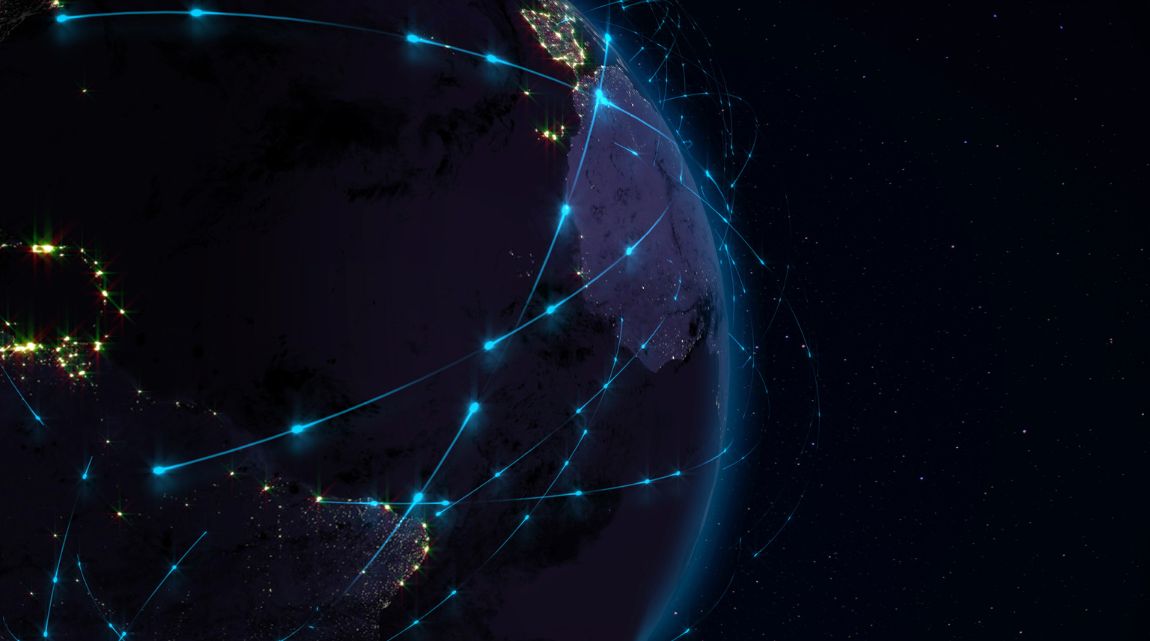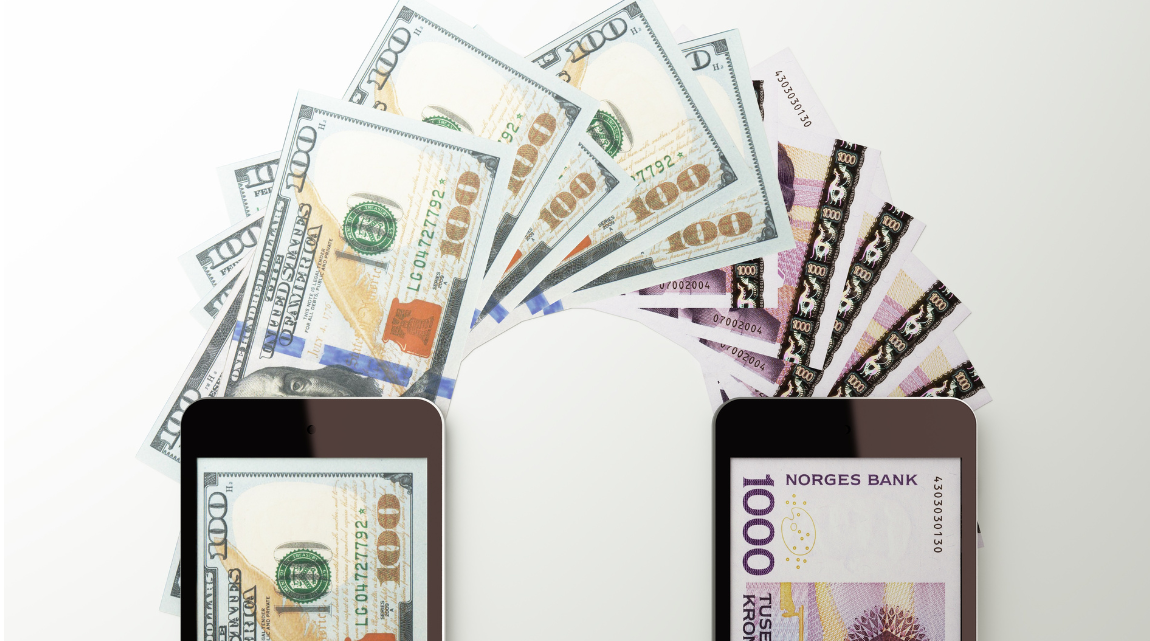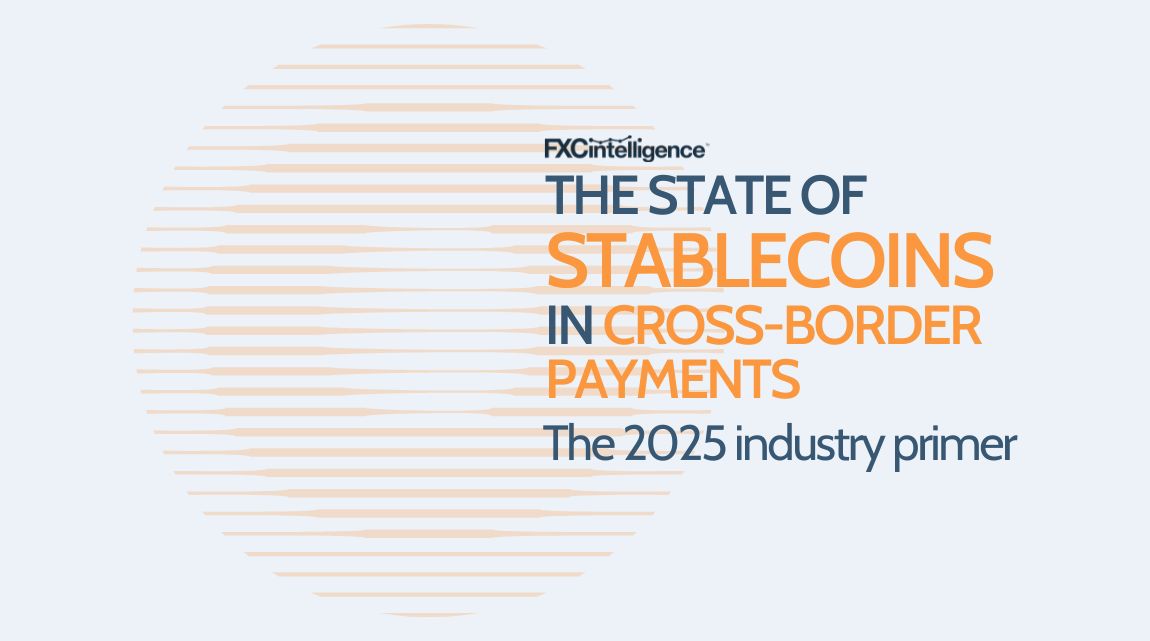The FSB has released the latest key performance indicators for the G20 Roadmap for Enhancing Cross-Border Payments. But how is the retail payments sector, and particularly P2P, performing against 2023 and the 2027 targets?
At the start of this week, the Financial Stability Board (FSB) published the latest update on progress against the G20 Roadmap for Enhancing Cross-Border Payments, an industry-wide initiative to improve speed, cost, access and transparency across wholesale payments, retail payments and remittances.
Presented in the form of an annual report on meeting targets set for 2027, as well as a consolidated progress report, this provides key performance indicators (KPIs) for the industry for the second year running. The FSB first published data on the industry’s performance against its 2027 targets in 2023, and this year the KPIs provide a sense of how much progress – if any – has been made.
The report includes extensive regional and market-type data, much of which is provided by FXC Intelligence. While the remittances segment is based on the World Bank’s Remittance Prices Worldwide dataset, which itself is supplied by us, data in the retail section of the G20 Roadmap is directly supplied by FXC Intelligence.
The retail section covers a broad set of areas of cross-border payments, across P2P money transfers; B2B payments for micro, small and medium-sized enterprises (MSMEs); B2P payments; and P2B payments. This sees data compiled from hundreds of bank and non-bank payment service providers across thousands of country-level corridors to produce region-level averages for each payment type.
As a result, there are insights for many players across the sector, particularly given that across retail payments, the FSB data shows that performance against the G20 targets has actually declined across most metrics between 2023 and 2024.
In this report, we dig into some of the details at both a global and regional level, including analysing the retail payments datasets published alongside the report, to determine some of the key lessons for the industry. This sees us focus particularly on findings for P2P, as well as broader insights for B2B & B2P as well as P2B.
2024’s G20 roadmap KPIs: Global retail payments are behind cross-border targets
At the top level, the retail section of the G20 roadmap KPIs showed no marked improvement in 2024 compared to 2023, with rising costs and reduced speeds across most metrics at a global average scale.
Global cross-border payment cost averages rose in 2024
The G20 roadmap is targeting global average retail cross-border payment costs of no more than 1% by the end of 2027, with no corridor seeing average costs above 3%. However, at a global level almost all use cases moved away from, rather than towards this goal.
B2B, which was the closest in 2023, saw a 0.1 percentage point rise in 2024, to reach an average of 1.6%. B2P, the second closest, increased by 0.3 percentage points to reach 2%. Meanwhile, P2P, which was already the highest, saw an increase of 0.1 percentage points to 2.6%. Notably, P2B was the only one to remain flat, at 2%.
The FSB has also noted that no sending region has achieved the targeted 1% average.
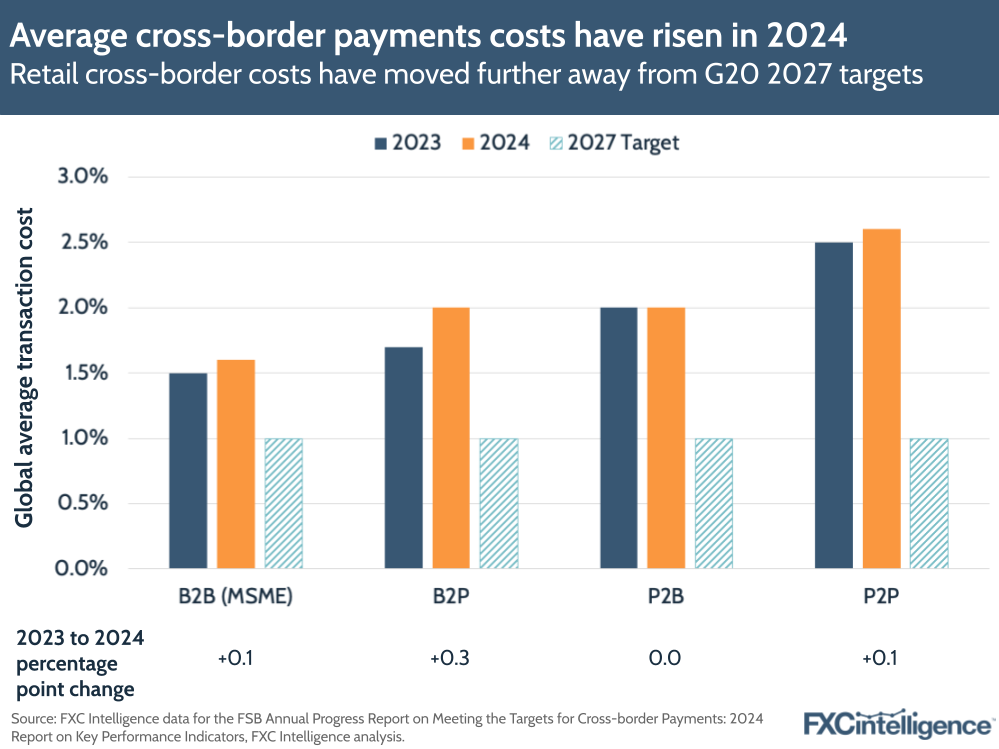
This lack of improvement between 2023 and 2024 means that all forms of retail payments need to make significant moves in reducing costs if they are to reach the 2027 target of 1%.
Our analysis shows that this will require yearly average cost reductions of between 15% (for B2B) and 27% (for P2P). This translates to a required percentage point reduction of around 0.2 for B2B each year between 2025 and 2027, while P2P will need to see reductions of around 0.5 percentage points each year over the same period.
B2P and P2B, meanwhile, will both need to see global average cost percentage point reductions of around 0.3 each year from now until 2027 if the target is to be reached.
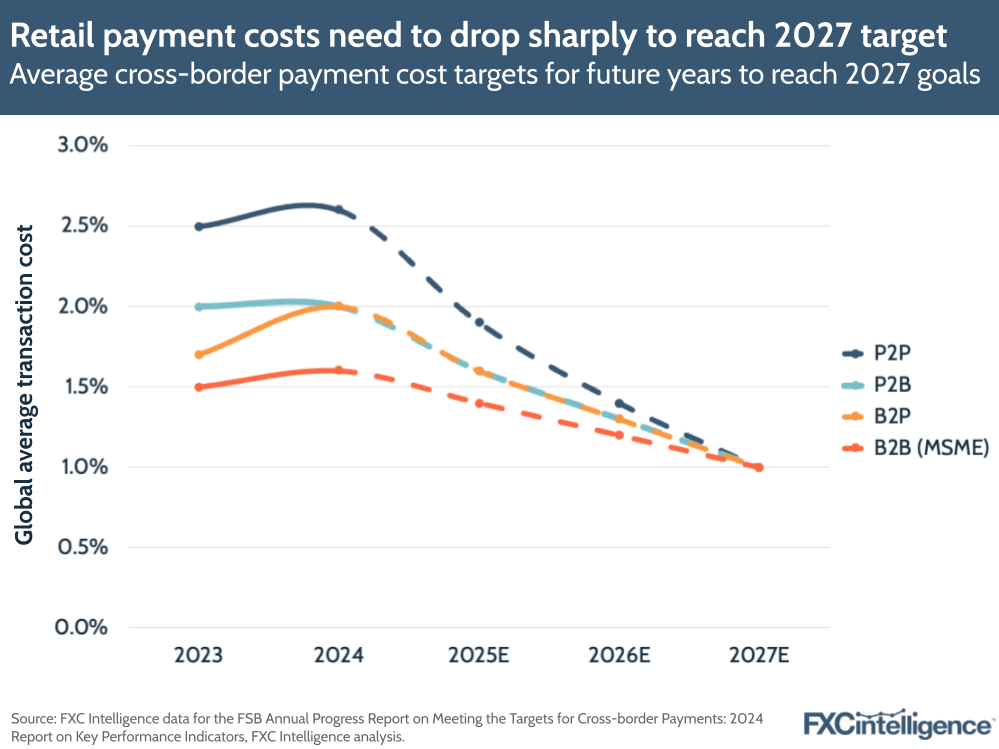
While averages have increased, so have the number of payment corridors above the target maximum of 3% for all retail payments, with this share at 0.4 percentage points above 2023 levels.
As of 2024, 24.1% of corridors have a cross-border retail payments average above 3%. This means that around 1,400 of the circa 5,800 corridors analysed as part of the research currently have averages above the target maximum.
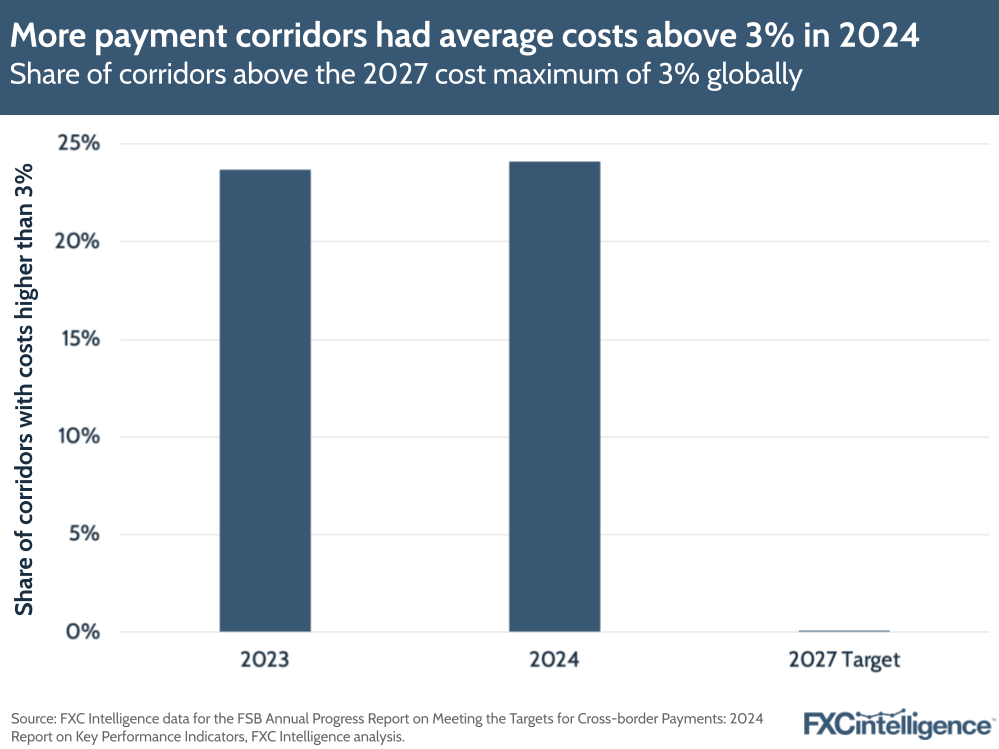
Global average payment speeds slowed in 2024
At a global level, retail cross-border payment speeds also slowed from 2023 levels, bringing them further away from the 2027 targets. The G20 roadmap has set a target for 75% of cross-border retail payments to be available to the recipient within one hour of sending by the end of 2027, with the remainder being delivered within one day. However, the share of transfers that were delivered in both one hour and one day reduced in 2024 compared to 2023.
Those delivered within one hour now stands at 33.5% after a drop of 0.7 percentage points, while those delivered after this but within one business day now stands at 35.4% – a 4.5 percentage point drop. This means that combined, the share reaching the one day maximum is now 69%, down from 74% in 2023.
The share now arriving after more than a day – above the maximum under the 2027 target – is now 31%, a 5.1 percentage point increase on 2023. In order to reach the targets, all of this share will need to improve speeds over the next three years, while 41% of the overall cohort not currently delivering in under one hour will need to improve speeds to do so.
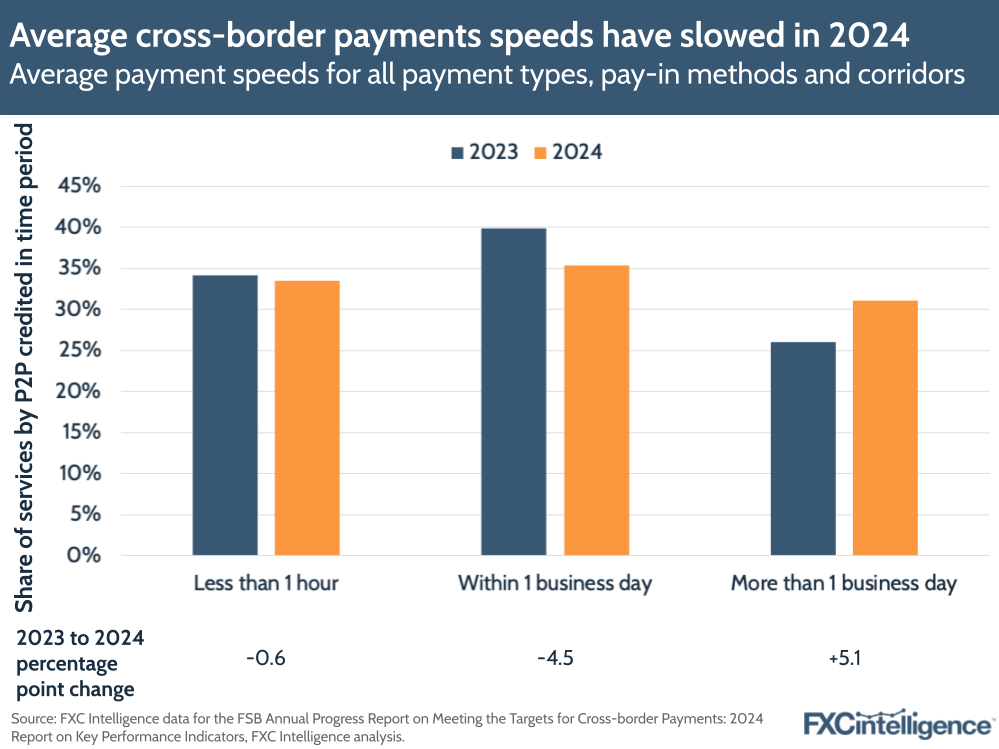
Transparency gains but PSP drop-out creates challenges
The FSB reports that there were some changes to the composition of the data cohort, with 17.3% of the payment service providers (PSPs) included in the 2023 retail payments dataset having dropped out of the 2024 sample, while 23.6% were new in 2024. There was significant variation in this by use case, with P2P seeing the lowest rate of drop-outs and additions, while B2B & B2P saw the highest.
This also had some impact on the number of new and lost corridors included in the dataset, which was most pronounced for P2B, while the FSB also revised its methodology for speed and transparency data in 2024, releasing restated 2023 data where appropriate.
Despite this, the rate of transparency in the data improved slightly between both years, with 1.1% shifting from only reporting cost and not speed to reporting both between 2023 and 2024.

How does FXC Intelligence underpin major payments datasets?
Changing costs and speeds in P2P money transfers
Analysis of the datasets provided alongside the report produces some interesting insights about the P2P money transfers sector.
This is distinct from consumer remittances, which typically focuses on migrants sending money home to support family and similar use cases, and has traditionally been cash-heavy. The FSB report includes a separate remittances section, which is reported under different metrics and has different targets in alignment with the UN Sustainable Development Goals, namely a global average cost maximum of 3% for $200 sends, with no corridor costs above 5%, by 2030.
For remittances, results were relatively flat across the leading cost metrics, with global average costs to send $200 averaging 6.4%, a 0.1 percentage point increase, while global average costs to send $500 remained flat at 4.3%. The number of corridors where costs were above target maximums did reduce, however.
By contrast, P2P money transfers is typically more digital-led and focuses more on use cases requiring higher send amounts use cases, such as transferring money across borders to make high-value purchases abroad. As a result, the G20 metrics for P2P track sending of $1,000 and $10,000 amounts, the cost of which saw increases for both between 2023 and 2023.
Despite having 2027 targets of 1%, global average costs to send $1,000 and $10,000 saw percentage point increases of 0.07 and 0.1 respectively, to 2.6% and 1.9%.
Our analysis shows that to reach that target, the global average cost to send $1,000 will need to reduce 27% each year from now until 2027, while the cost to send $10,000 will need to reduce by 19% each year. This is equivalent to a 0.7 percentage point reduction in 2025 for $1,000 sends and a 0.4 reduction for $10,000 sends.

The most expensive regions for P2P payments in 2024
The datasets published alongside the report by the FSB include data at a regional level, providing the ability to identify areas where there is a need for particularly significant cost reductions in order to meet the 2027 targets.
Looking at the average cost to send globally by region, the most expensive to send both values is Latin America and the Caribbean (LAC), where weighted average costs in 2024 reached 3.95% to send $1,000 and 3.8% to send $10,000. Sub-Saharan Africa (SSA) was the second most expensive sending region globally, reaching 3.8% for $1,000 and 2.97% for $10,0000.
For both, this was an increase on 2023, when weighted average costs for LAC were 3.7% and 2.7% respectively, while for SSA they were 3.2% and 2.5% respectively.
By contrast, Europe and Central Asia (EUCA) and South Asia (SA) were the least expensive to send $1,000 from in 2024, at an average of 1.97% and 2.49% respectively, while for $10,000 it was EUCA and East Asia and Pacific (EAP) at 1.53% and 1.69%.
EUCA did see a modest improvement on 2023 for the lower send amount, which a year ago stood at 2.1%, however SA and EAP were both slightly above 2023 levels. Crucially, no region reached the target 1% at a global average level in either year.
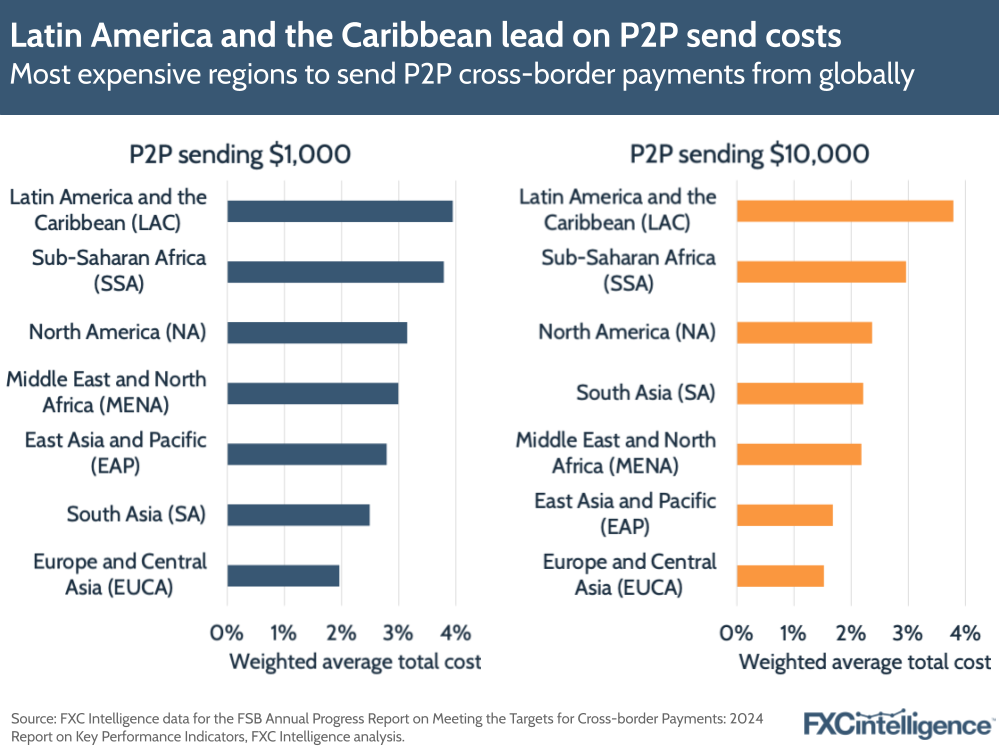
Looking at average costs to send P2P payments globally to specific regions, SSA was the most expensive for both use cases, at 3.15% for $1,000 and 2.51% for $10,000. Meanwhile, SA was cheapest to receive $1,000 (1.99%) and EUCA was cheapest to receive $10,000 (1.54%).
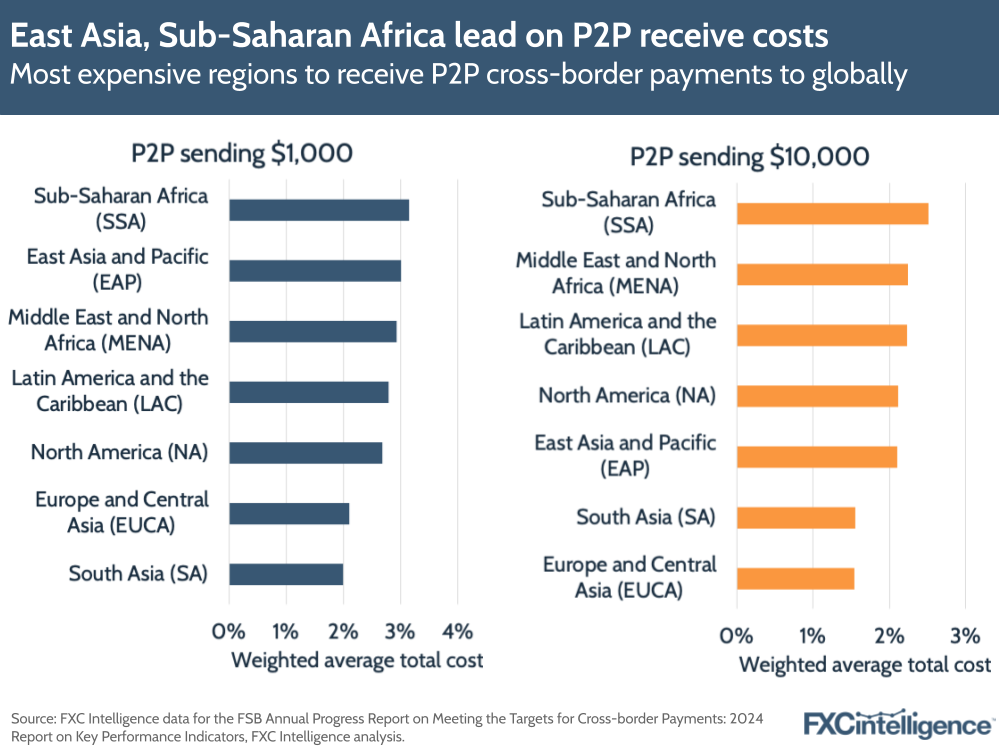
At a regional corridor level, LAC to LAC was most expensive for both send amounts, at 6.48% for $1,000 and 5.18% for $10,000. This makes it almost a percentage point more expensive than the next most expensive regional corridor at the $1,000 level, LAC to Middle East and North Africa (MENA), and similarly more expensive than the next at the $10,000 level.
Notably, LAC to LAC has seen sharp increases compared to 2023, when the weighted average cost was 4.7% to send $1,000 and 3.9% to send $10,000.
LAC and SSA see significant representation in the most expensive 10 regional corridors, both on the send and receive side.

The least expensive regions for P2P payments in 2024
By contrast, the least expensive regional corridors for P2P payments in 2024 were Europe and Central Asia (EUCA) to South Asia (SA) for $1,000 and East Asia and Pacific (EAP) to North America (NA), at 1.46% and 1.23% respectively.
Even at this level, these regional corridors remain above the 1% target for 2027, and both saw increases compared to 2023, when their weighted average total costs were 1.6% and 1.1% respectively.
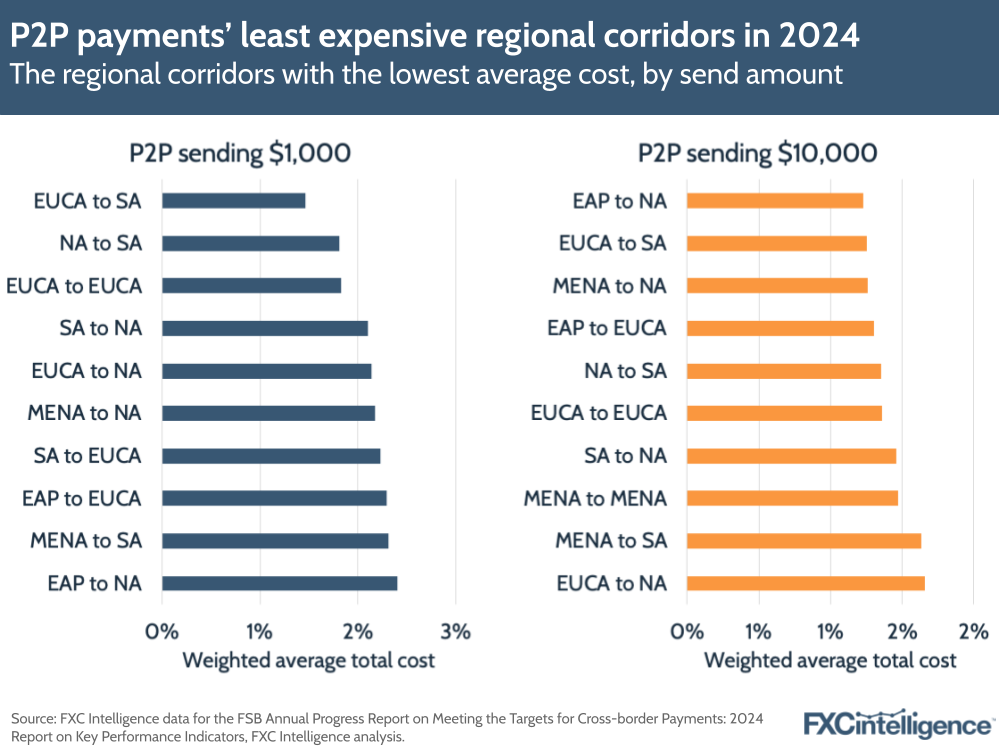
Which regions have seen the biggest price P2P changes?
Price increases have been widespread across P2P regional corridors. Of the regional corridors where data was available for both 2023 and 2024 – the vast majority of the dataset – 55% of those for sending $1,000 and 54% for sending $10,000 saw a cost increase.
While LAC to LAC was an outlier for sending $1,000, with a 1.83 percentage point increase, nine regional corridors for $1,000 and eight for $10,000 saw increases of at least half a percentage point. Notably, intra-region corridors were disproportionately present on the sending $1,000 list, with SA to SA and MENA to MENA both also among those seeing the biggest increases.
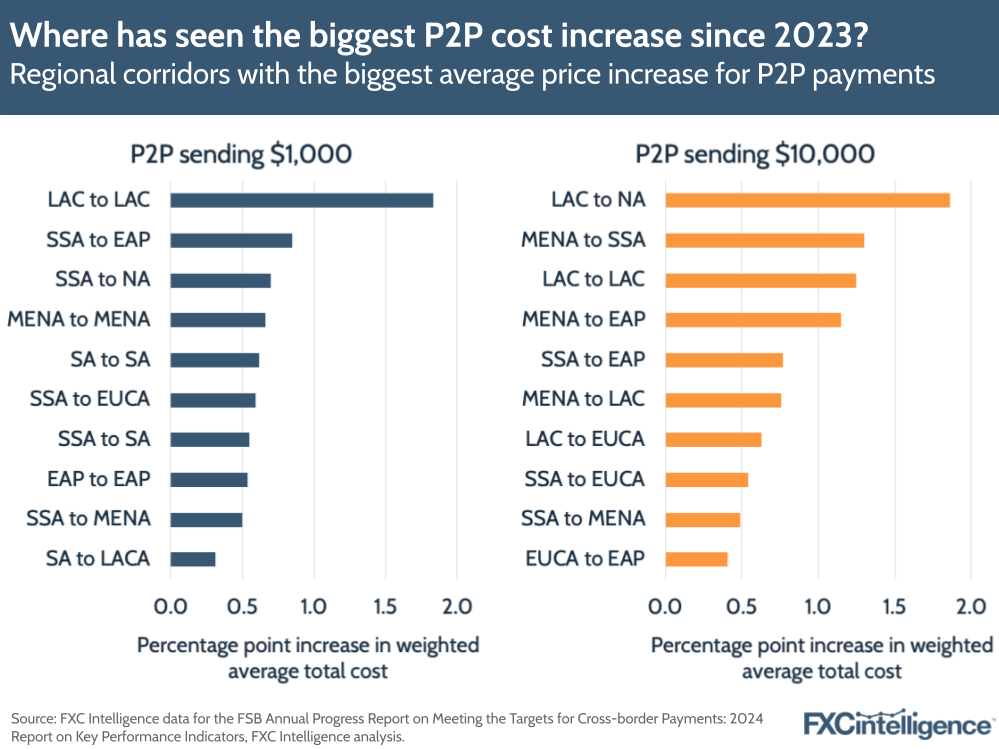
Despite the global average increase in costs, there were regions that saw decreases, with 45% of regional corridors seeing cost reductions between 2023 and 2024.
MENA to SSA saw the biggest reduction for $1,000, declining by 1.31 percentage points, while SSA to LAC led declines for $10,000 with a 1.57 percentage point drop. Five regional corridors saw declines of over half a percentage point for $1,000, while four did so for $10,000.

How close is P2P payments to 2027’s 3% target?
Adherence to the other major target for P2P payments, where no corridors have an average cost of above 3%, also remains a challenge, with 31% of country corridors not yet achieving this target for $1,000 and 15% not achieving it for $10,000.
There were signs of decline here too: sending $1,000 saw a 2.95 percentage point increase in the number of country corridors above 3% and at $10,000 this had increased by 6.95 percentage points between 2023 and 2024.
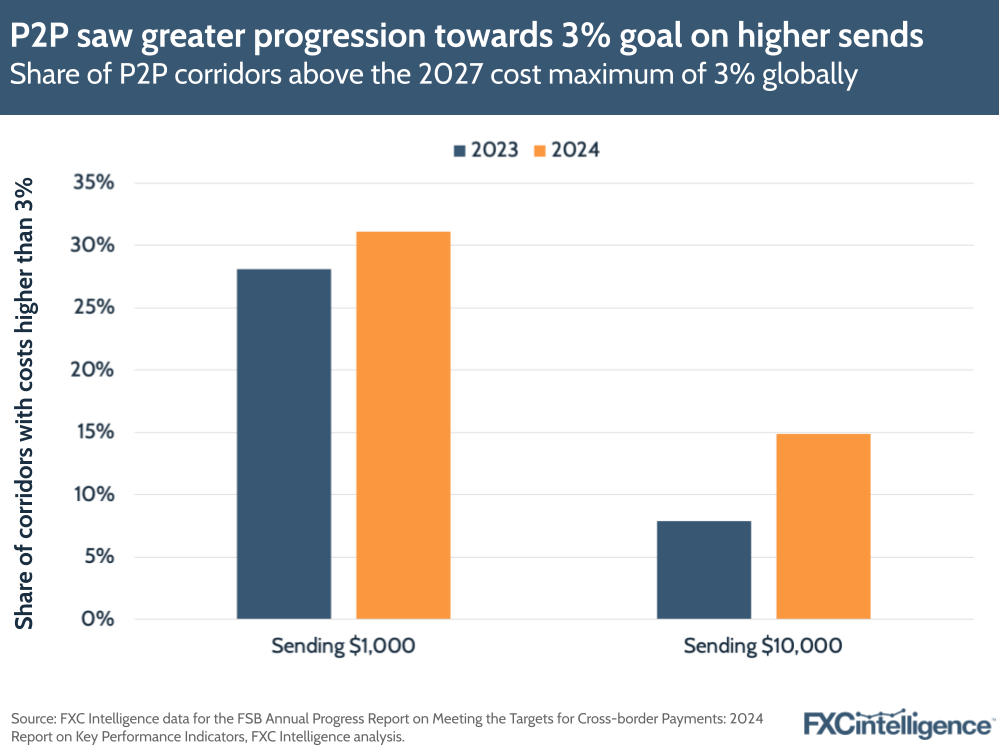
Looking regionally, some areas have far more work than others to get to the 3% target. Three regional corridors see all country corridors breaching this cost average when sending $1,000, while one does at the $10,000 level. A disproportionate number of these are also in regional corridors where SSA and LAC are either the sender or receiver.
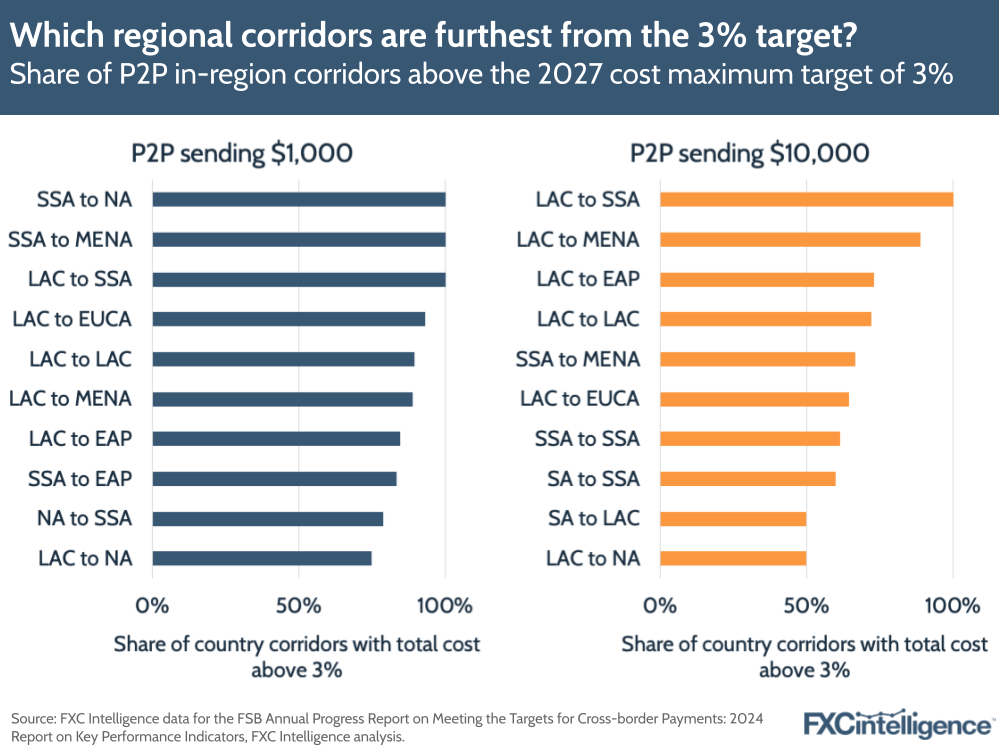
Despite this, there are also regions where no corridors average above three percent, with eight of these when sending $10,000 and four when sending $1,000. Of these, South Asia (SA), North America (NA), Europe and Central Asia (EUCA) and Middle East and North Africa (MENA) are disproportionately represented.
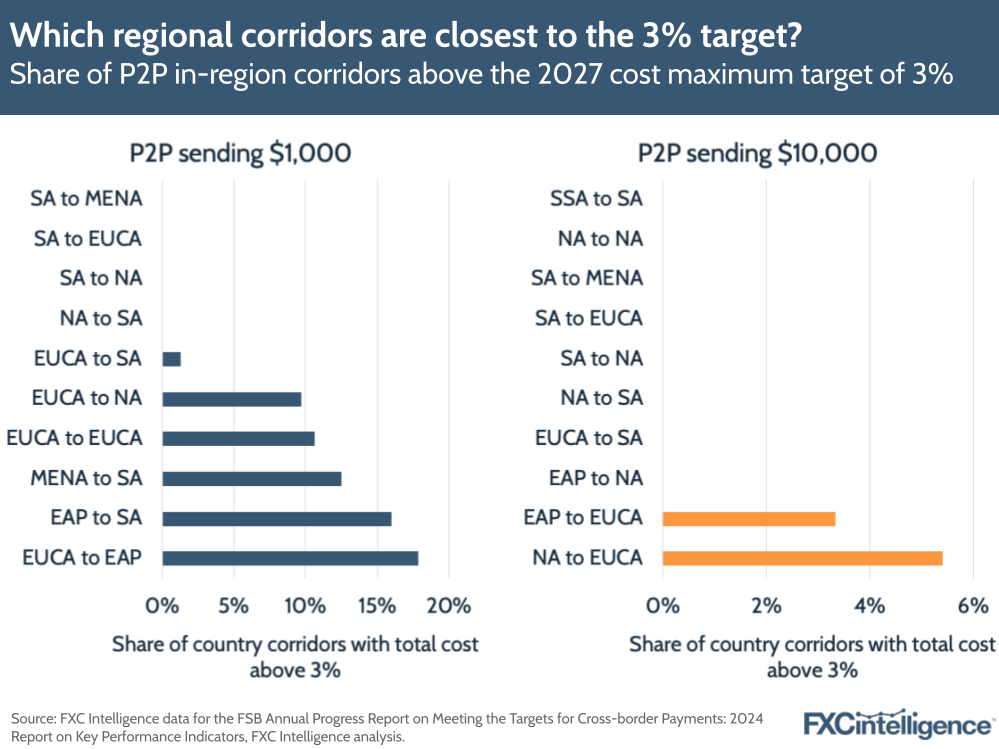
P2P payments’ speed performance
Looking to speed, the P2P segment of retail payments is not yet achieving the target of all payments being sent in under a day and 75% being sent in under an hour. On average, 46% were sent in an hour for $1,000 sends while 42% were sent in an hour for $10,000 – a further 31% and 35% respectively were sent in a day. However, some payment types are closer than others.
Cash achieved the under one hour target for both payment amounts, with a weighted share of 77% of $1,000 cash payments sent in under an hour, and 82% for $10,000, but still had a small percentage being sent in over a day. Mobile wallets were also close, achieving 66% and 62% respectively of under one hour sends, while cards and bank accounts have further to go.
However, there were some declines in speeds for P2P payments in 2024 compared to 2023. While on average the share of under one hour sends increased, the share under a day grew by a greater amount, with average increases in sends taking over a day to arrive.
This was driven in particular by a jump in bank account sends taking longer, with a 4.6 percentage point increase for $1,000 sends taking over a day to arrive and a 12.4 percentage point increase for $10,000 sends.
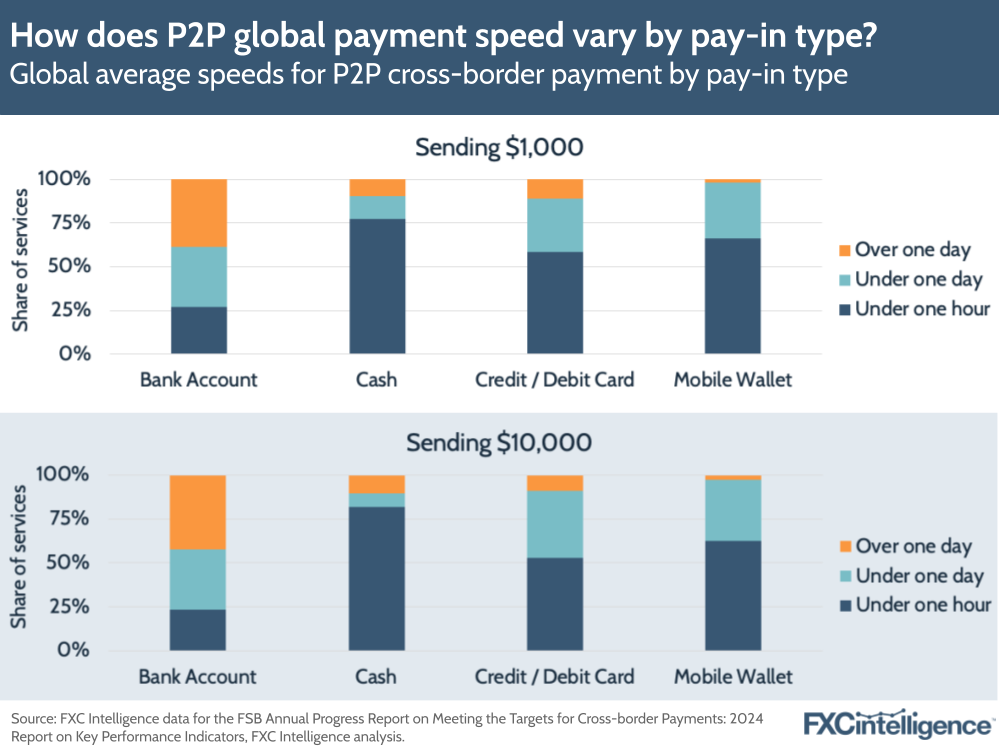
Some regions also saw differences in speed, with LAC to SSA being the fastest across both send amounts for the average of all payment types, with more than 80% of $1,000 sends and 90% of $10,000 sends arriving within an hour.
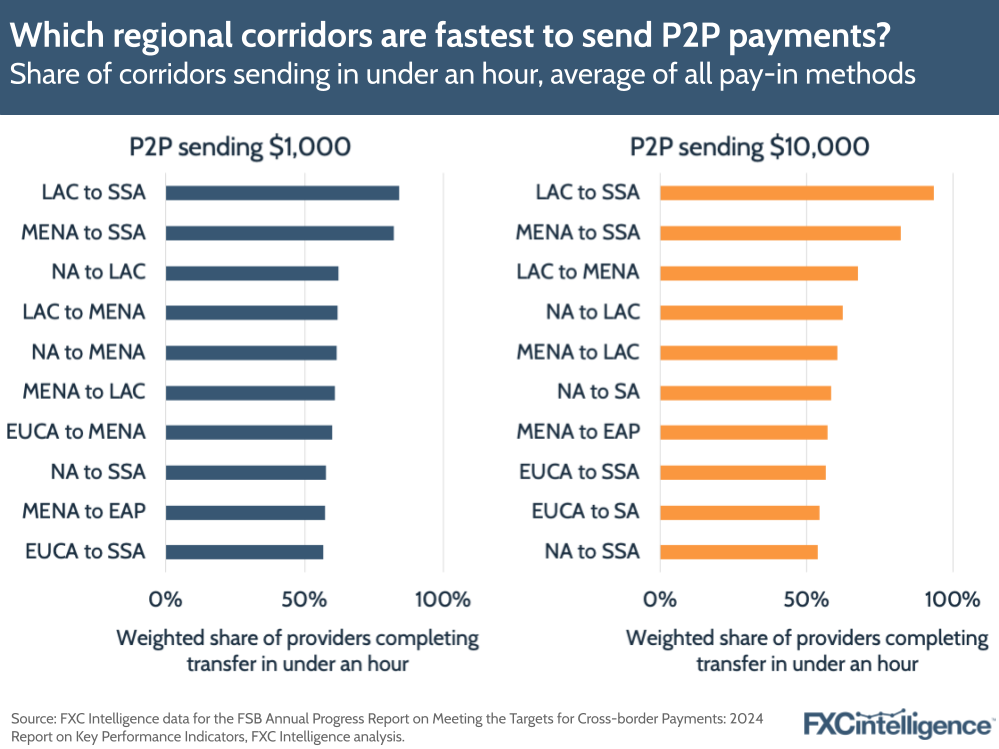
How can FXC Intelligence’s market sizing data help me grow my business?
B2B & B2P cross-border payments: Rising costs, slowing speeds
Away from P2P payments, the FSB also supplied combined in-depth data for B2B & B2P, where average costs rose in 2024. The global average cost saw a roughly 0.2 percentage point increase for both the $5,000 and $20,000 send values, to 1.95% and 1.62% respectively.
Despite this, B2B & B2P is in a stronger position than P2P to meet the 2027 target of 1%, requiring yearly average cost reductions of around 20% for the lower send amount and 15% for the higher. This means that the average percentage point reductions for 2025 will need to be 0.4 for $5,000 and 0.2 for $20,000 to be on track to achieve the target.

This segment also saw an increase in the share of corridors globally that are breaching the 3% average maximum cost for B2B & B2P, with $5,000 seeing a 3.51 percentage point increase to 9.81%, while $20,000 saw a 4.45 percentage point increase to 7.8%. However, the overall share of corridors above the 3% target remain well below the share for P2P payments.
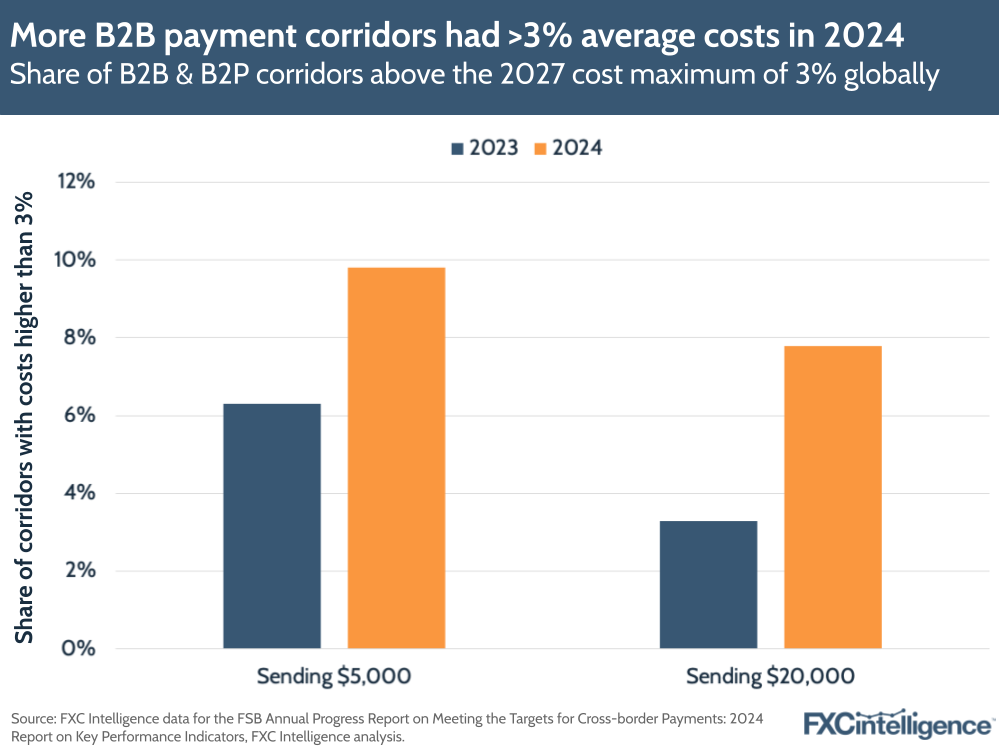
Looking to the regions with the most expensive send costs for B2B & B2P, Sub-Saharan Africa (SSA) is highest for both send amounts, averaging 3.35% for $5,000 globally and 2.98% for $20,000. By contrast, Europe and Central Asia (EUCA) is the lowest for both, with 1.45% and 1.12% respective averages sending globally in 2024.
However, both have seen increases since 2023. EUCA saw respective averages of 1.2% and 0.8% in 2023, while SSA saw 2.6% and 2.8%.
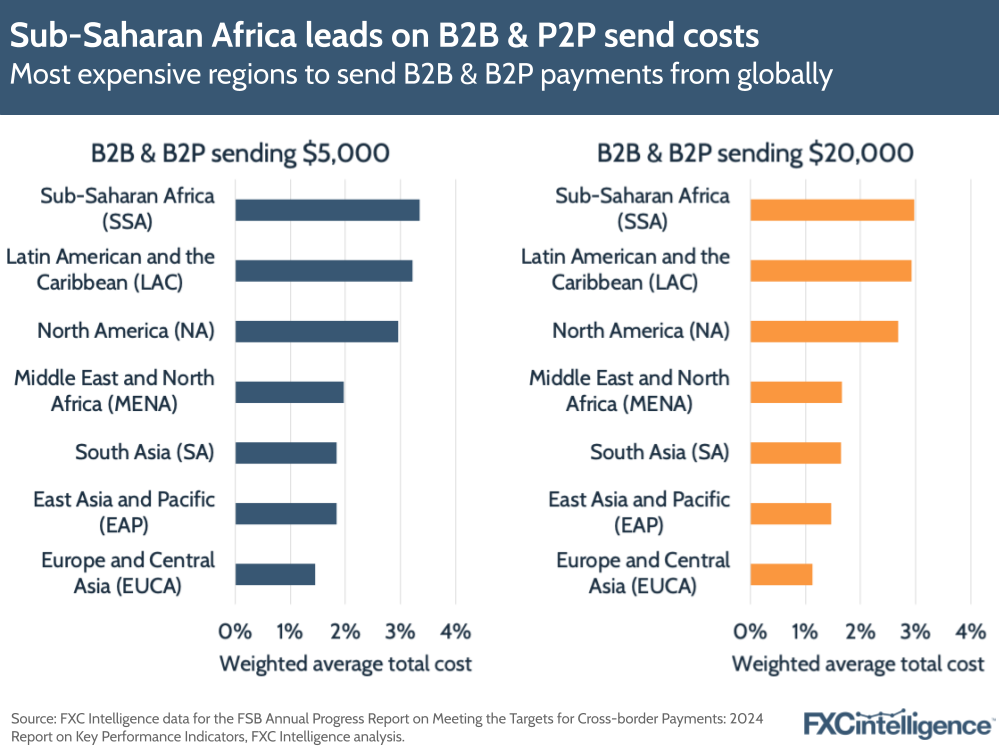
Speeds for B2B & B2P also have some way to go, particularly for mobile wallets where all corridors saw average speeds above the one-day target maximum. Here, cards saw the best performance, with only around 11% of $5,000 sends and 23% of $20,000 sends taking over a day to arrive, while more than 10% of the lower value and more than a quarter of the higher value took less than an hour.
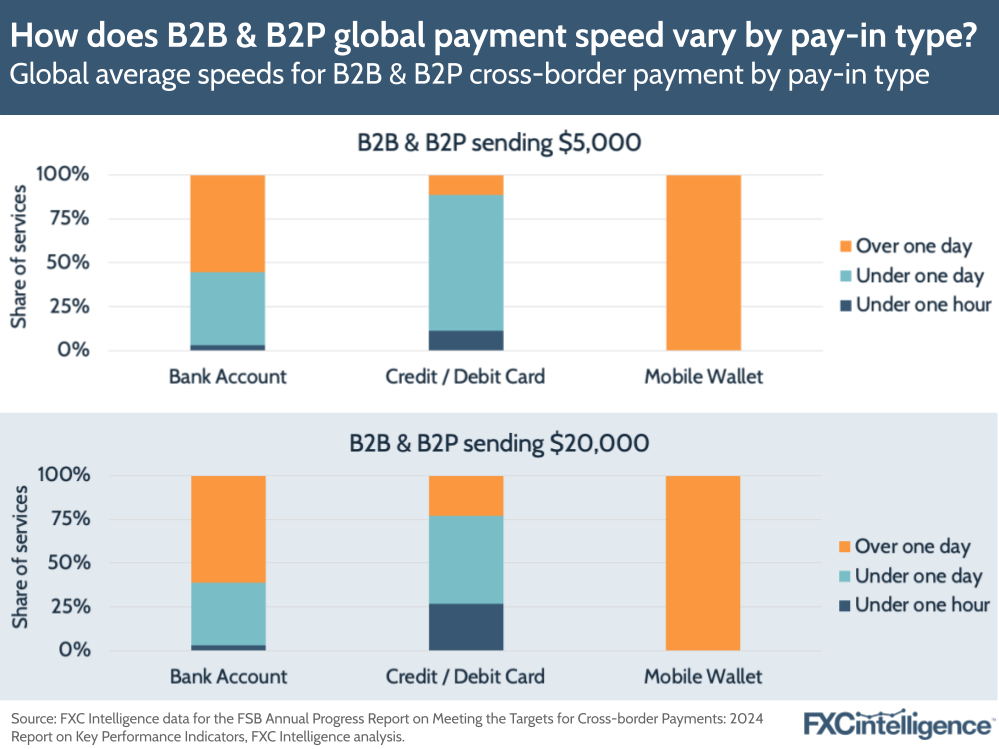
Cost improvements in P2B cross-border payments
P2B payments, meanwhile, is a rare positive sign within the wider data. While detailed regional-level data is only available for costs and not for speed, total costs remained essentially flat for both $100 and $1,000 send values, with the latter seeing a very slight decline from the previous year.
However, with both send amount costs being around twice the 2027 target of 1%, global cost reductions for P2B will need to be achieved at a rate of 21% per year for $100 sends and 20% for $1,000 sends to reach the goal. This is equivalent to a 0.4 percentage point reduction for both in 2025.

The 3% target also saw signs of positive movement for P2B in 2024, with declines in the share of corridors with average costs above this level over the past year across both send amounts. However, shares for both still sit at around 30%, meaning there are still well over 1,000 corridors where costs need to be reduced to meet this target.
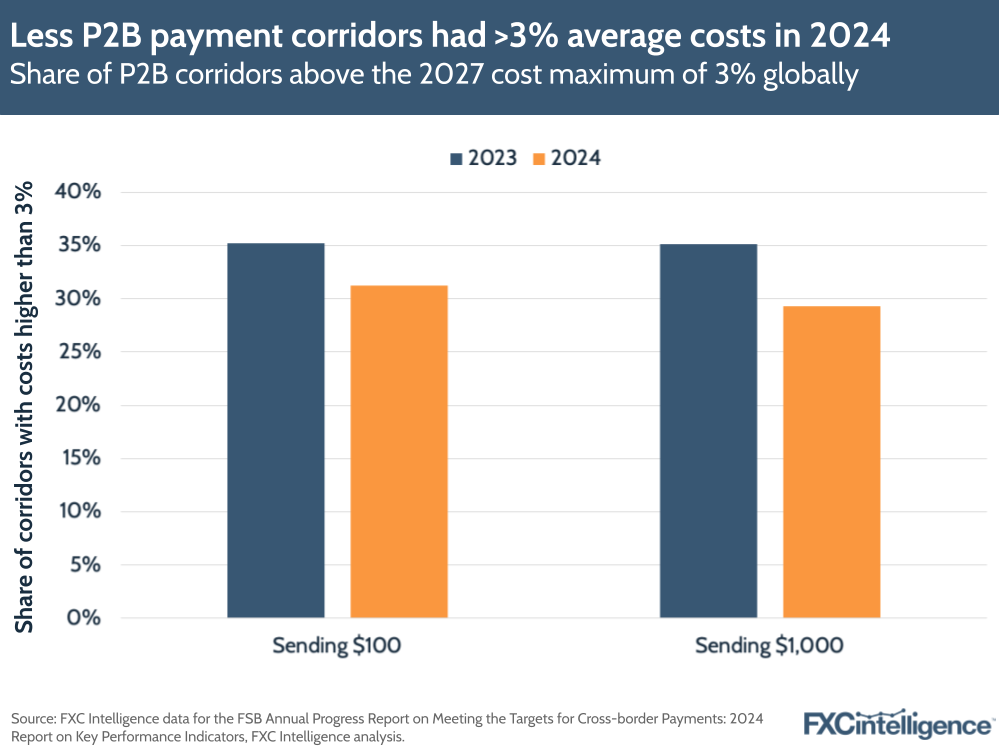
Looking at regions where cross-border P2B payments are most expensive to send on average, South Asia (SA) leads with an average of 3.67% for both send amounts to send to all regions globally. By contrast, Europe and Central Asia (EUCA) and North America (NA) are the two cheapest on average, at 1.66% and 1.75% respectively to send $100 and 1.52% and 1.75% respectively to send $1,000.
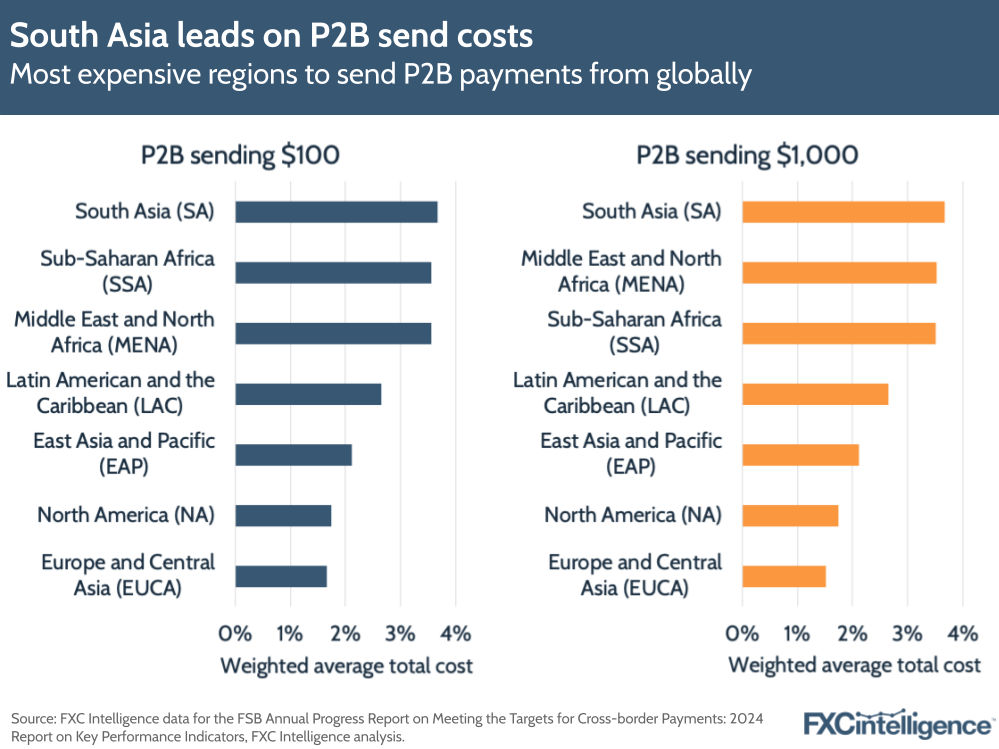
As with other retail payment types, LAC and SSA are disproportionately represented on the most expensive regional corridors, along with MENA. LAC to SSA has the highest weighted average total costs for both send amounts, at around 4.8% for both values.
By contrast, EUCA to EUCA is the cheapest, with weighted average total costs of 1.31% to send $1,000 and 1.45% to send $100. Again, no regional corridor saw average costs at or below the target of 1%.

How can data help my bank or payments organisation?
Industry efforts and future challenges
The publication of the second set of G20 roadmap KPIs has ignited increased industry interest, particularly among B2B2X players, many of whom have stepped up discussion as they look to highlight how their solutions can help P2P companies, particularly banks, improve their offerings in line with the targets.
Meanwhile, many central banks have also discussed the roadmap, with our analysis of published transcripts of speeches by G20 central banks showing that around a quarter have discussed the topic during at least one speech in the past year.
Of these, the UK and the US mentioned the roadmap the most, with references appearing in around a third of Bank of England speeches and 40% of US Federal Reserve speeches. Others who made references included France, Germany and Australia.
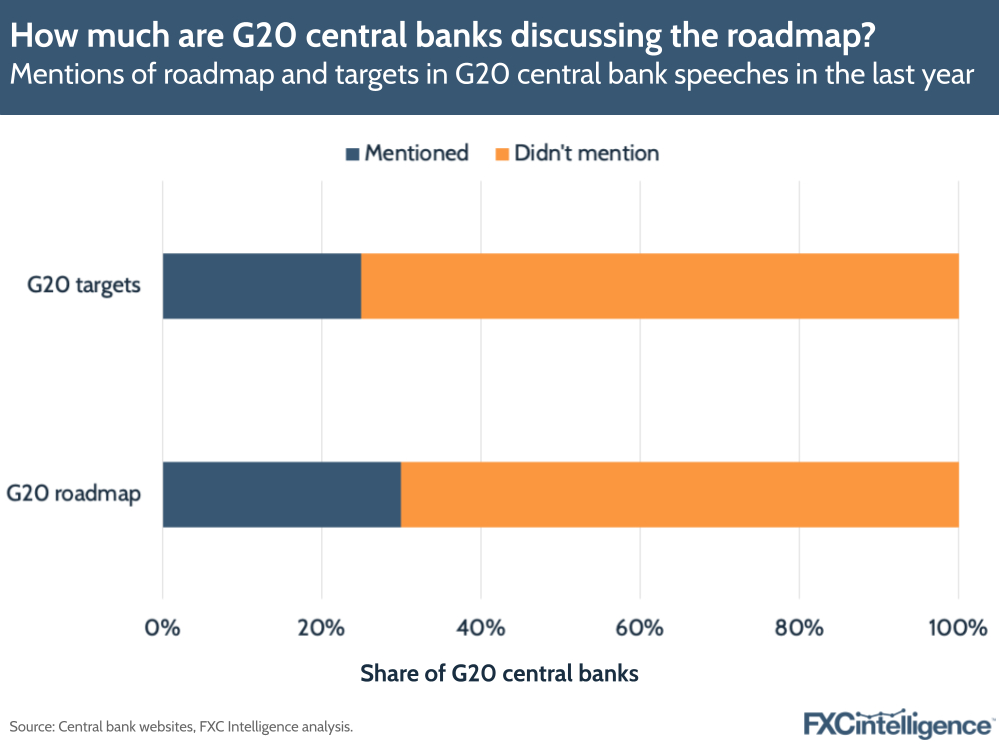
However, it is clear that this year’s update is one that not many would have hoped for and shows how much more work there is to do if the targets are going to be reached by 2027, or even by the end of the decade.
While costs have increased on average, certain regions are disproportionately driving these, particularly those that in the past have been greater sources of remittance business than P2P or other forms of retail payment, highlighting areas of opportunity for the industry to increase competition.
The retail cross-border payments industry is in the middle of a years-long transition towards more digital tools, and there is still considerable work to be done to continue this, particularly when it comes to the sophisticated use of and response to data. Such tools can be powerful ways to improve revenue and reduce operational overheads, and are therefore vital in the pursuit of these targets.
While there is some way to go, there is still significant potential to make progress towards the goals over the coming years, and it may take some time for industry efforts to fully translate into cost reductions and speed increases for customers. However, with such a strong need to improve, particularly in some regions, there are clear opportunities for many cross-border payment players.
